It’s that time of year again when the weather can be unpredictable in many states, especially at night. We are often asked by new cold-weather RVers what to do when the forecast is showing under 32º.
We’ve spent the last several winters camping in our fifth wheel, so here are our best tips for full-time RVing in cold weather when the temperature dips below freezing!
This post may contain affiliate links. As an Amazon Associate, I earn from qualifying purchases. I may receive a small commission when you make a purchase using my links at no extra cost to you. Thank you for your support!
1. Keep an Eye on the Weather
One of the most crucial aspects of planning a successful winter RV camping trip is keeping a close watch on the weather conditions.
Knowing when to expect freezing temperatures, snowfall, or icy conditions is essential to make sure you have a safe and enjoyable camping trip.
There are numerous weather apps and websites that you can use to keep an eye on the weather, but our personal favorite is the StormShield app.
Be sure to monitor not only the current weather but also the extended forecasts.
Knowing when a cold front is expected to move in or when a winter storm is on the horizon can help you make informed decisions about your route, camping location, and necessary supplies.

2. Unhook and Drain Water Hoses
When cold weather RVing, leaving your hoses connected to the water spigot when it’s freezing out is a recipe for trouble.
We’ve learned this the hard way, and let me tell you, it’s no fun dealing with frozen hoses and potential damage to your RV’s plumbing!
So, what do we recommend? Take the time to disconnect those hoses and drain them properly.
After that, store them away in your RV storage area, where it’s nice and warm. This not only keeps them from freezing but also helps prolong their lifespan. Win-win!
An alternative to this would be purchasing a heated water hose. There are heated water hose options for temperature ratings of -20º or -40º, depending on what you need for your travel trailer.
You can also use heat tape on your water spigot to keep it from freezing at the source during winter camping.
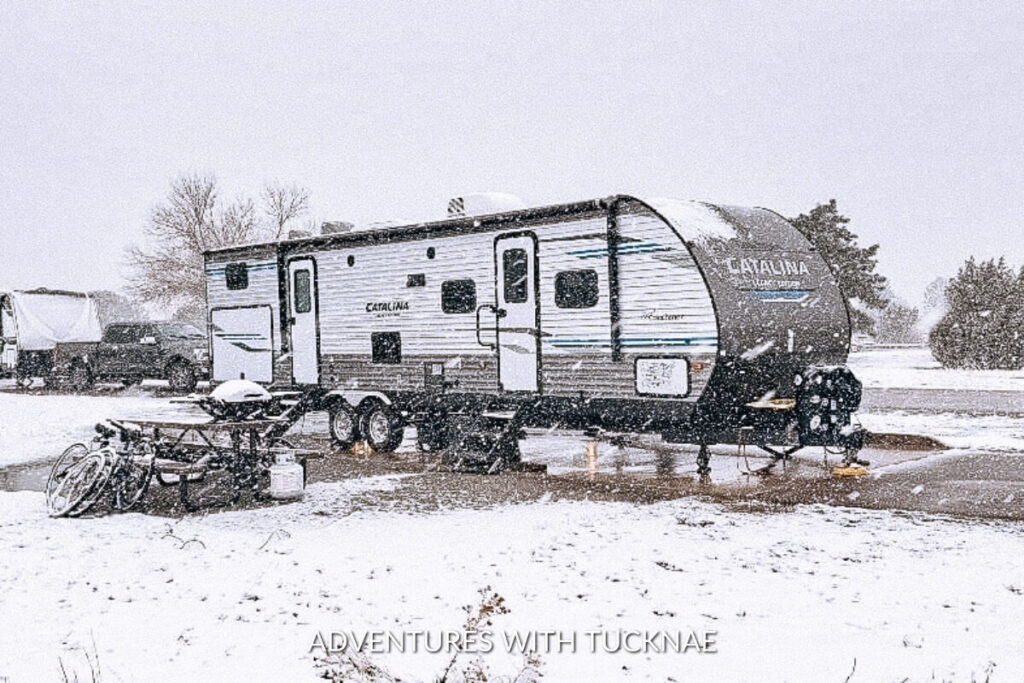
3. Disconnect RV Water Filters and Bring Them Indoors
Living full-time in an RV in winter can have its costs for sure. We have made the mistake of leaving a water filter outside, only to discover that once frozen, they bust and have to be replaced.
This goes for all water filters, regardless of the brand.
If you’re RVing in freezing weather, we’ve found that bringing your filters inside is the best way to protect them. Place them in a sink to prevent any water from leaking out overnight.
Learn from our mistake, and save yourself the hassle and cost of replacing busted water filters!
We have chosen to use the ClearSource triple canister water filtration system to filter our water. We run all of our water through this system before it enters our rig.
Use code TUCKNAE25 for $25 off of any ClearSource water system! This is one of our main RV essentials that we recommend you get.
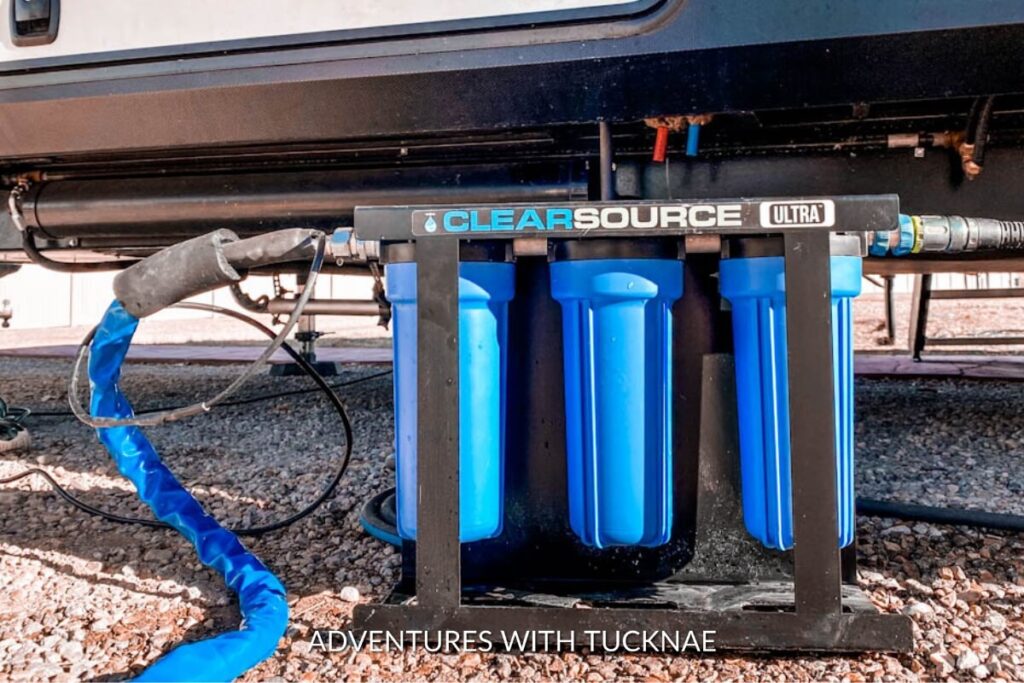
4. Keep Your Holding Tanks From Freezing
If your RV is equipped with holding tanks with a built-in heating element, switch it on whenever the temperatures are expected to dip below freezing.
This simple thing can be a game-changer, allowing you to continue using fresh water even when you’ve disconnected your water hoses.
On the flip side, a word of caution: if your fresh water tank doesn’t have a heating element, it’s best to avoid filling it up during freezing weather.
Why? Because when the water inside freezes, it can expand and potentially damage or burst your tank. The last thing you want during your winter camping trip is to deal with a busted tank!
5. Leave Your Faucets on Drip
The idea is simple: moving water is less likely to freeze. So, by leaving your faucets open just a bit to let them drip, you’re creating a constant flow of water through your plumbing system.
This minimizes the risk of your water lines freezing. We usually leave both the bathroom faucet and the kitchen faucet open to drip overnight.
Oh, and here’s a quick note on your sewer hose: never leave it connected or open when you’re not actively using it. Doing so can allow cold air to creep up into your RV, which is definitely not something you want.

6. Open the Cabinet Doors Under Your Sinks
Wondering how to keep RV pipes from freezing while camping in cold weather?
Leaving the cabinet doors under your sinks open can allow warm air to reach your water pipes and helps to keep the air temperature regulated.
Have you ever opened the cabinet door under your sink in the winter and felt the immediate difference in the air temperature under the sink in the cabinet?
Leaving the door open helps keep the air temperature regulated and keeps cold air from collecting under your sinks.
We’ve also found that doing this can prevent condensation from forming under your sink and potentially causing water damage.
You may also want to consider putting a Damp Rid container under your sinks, which brings us to our next tip!

7. Run a Dehumidifier or Use Damp Rid to Keep Indoor Condensation Down
When you’re camping in cold weather, you’ve probably noticed that as the temperature drops outside, condensation tends to form on your RV windows inside.
If left unattended, this moisture buildup can lead to potential water damage. So, here’s a tip to keep your RV interior dry and comfortable.
We run this dehumidifier, and let me tell you, it’s always surprising to see just how much moisture it can collect in such a short time.
If you don’t want to purchase a dehumidifier, you can also use Damp Rid containers throughout your rig.
They are designed to collect and trap the extra moisture in the air. You can find them at your local Walmart or order them online.
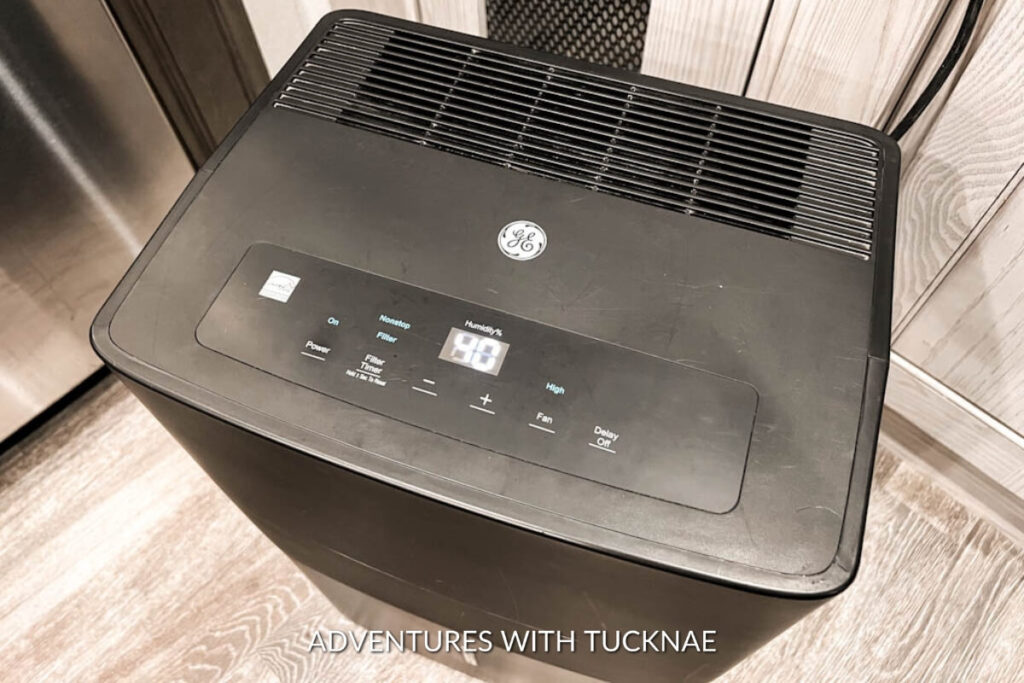
8. Add RV Skirting to Your Rig if You are Stationary
If you’re stationary for a while, adding skirting around your RV can be a game-changer. We opted for vinyl skirting on our rig, which made a big difference in our winter RVing experience.
RV skirting serves as a protective barrier around the base of your RV, and it helps to create an insulated environment underneath.
Even if your RV comes with an enclosed underbelly, skirting can still prevent your holding tanks from freezing and retaining the precious heat within your rig.
One of the immediate benefits we noticed was the improved temperature regulation underneath our RV.
It allowed us to go through the entire winter season without any issues with our tanks or water lines freezing, even with sub-zero temperatures and tons of snow!
The upfront cost of RV skirting might seem like an investment, but it’s an investment that pays off in the long run.
By keeping your RV better insulated, you’ll use less propane to stay warm, saving you money in the process.
If you want to learn how to install RV skirting yourself, you can check out our DIY RV Skirting post. It’s a worthwhile project, especially if you make stationary winter RV living a part of your plan.
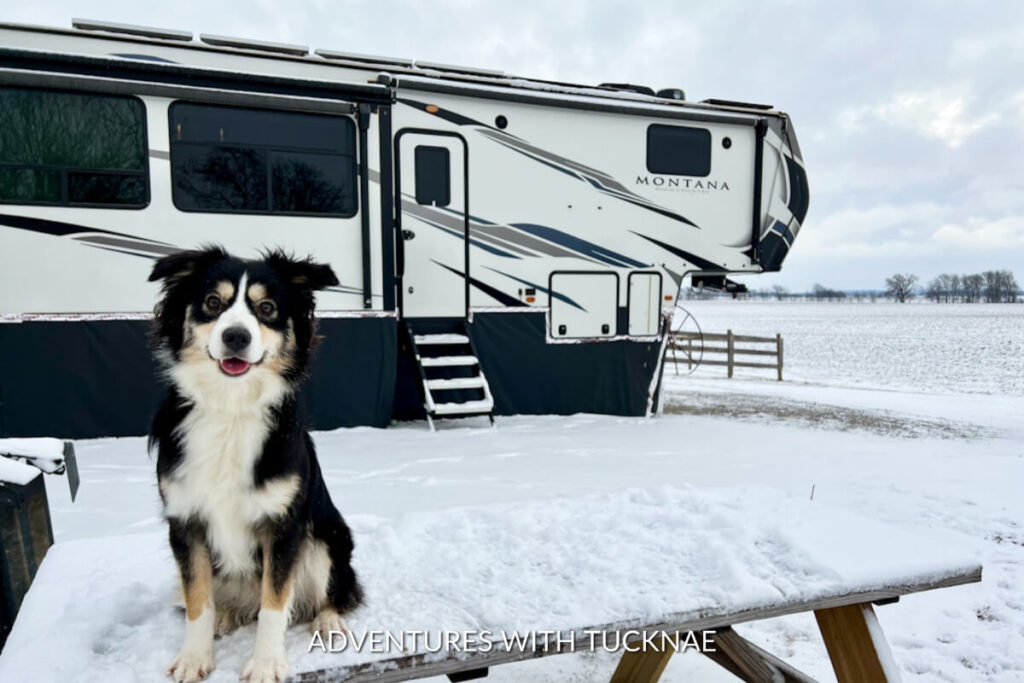
9. Run Your Furnace and Supplement Heat with Space Heaters
When we hit the road in our travel trailer during the winter, we’ve faced some frigid days and nights, often below freezing for extended periods.
To save on propane (because, let’s face it, those tanks can run dry fast in the cold), we added a couple of electric heaters to our setup.
But here’s where we goofed: We relied entirely on those space heaters, which made our living space toasty warm, but we had no clue our water tanks were turning into ice blocks until we tried to turn on the faucet!
So please don’t make the same heat source mistake we did. Instead, run your RV’s furnace alongside your space heaters.
While space heaters are excellent for making specific areas comfy, they probably won’t heat every part of your RV, especially the underbelly where your water lines run.
Your furnace can help distribute the warmth and, more importantly, keep those crucial water lines from freezing.
Most RVs like ours run heat throughout the entire RV, including the underbelly, which helps to keep your tanks, pipes, and water lines from freezing.
That being said, we highly recommend investing in a good electric space heater for RVing in winter as well! They’re great for warming things up quickly and supplementing your propane usage.

10. Monitor Your Propane Levels
Propane is a lifeline in the cold, serving as a source of heat for your furnace, hot water, and even your stove if you plan on cooking warm meals in your RV.
Running out of propane during a winter excursion can quickly turn an adventure into a shivering ordeal, so here are some tips on monitoring your propane levels effectively.
Start by investing in a propane tank gauge or sensor. They provide a real-time reading of your propane levels, allowing you to know precisely how much fuel you have left.
This knowledge is invaluable; it helps you plan refills or replacements well before running out.
It’s a small investment that can save you from the discomfort and inconvenience of unexpectedly running out of propane in the middle of a cold night.
In addition to using a tank gauge, make it a routine to inspect your propane tanks visually. Check for any signs of damage, rust, or loose connections.
Leaks or other issues can be dangerous and costly, so catching them early is crucial. Ensure that your propane tanks are secure and that there are no obstructions or debris around them.
This enhances safety and allows for proper ventilation, which is essential when using propane appliances.
Another smart practice is to keep spare propane tanks on hand. An extra tank or two can provide a safety net, especially if you’re camping in a remote area where refilling can be challenging.
When you notice that one tank is running low, you can easily switch to a full one without interrupting your comfort or worrying about finding a propane refill location in a hurry.
Always store spare tanks upright in a well-ventilated area and away from heat sources or open flames.

11. Check Your Tires
When embarking on a winter RV camping journey, your tires are crucial in ensuring safety and peace of mind.
Cold winter weather can significantly affect tire performance, so it’s essential to take extra care when it comes to tire maintenance.
Here’s what you need to know about checking your tires for winter RV travel.
Start by inspecting your tires’ condition. Check for wear, damage, and adequate tread depth.
Tires with worn-out treads are less effective at gripping the road, which can be especially risky in cold and wet conditions. If you spot any significant wear or damage, consider replacing them before you hit the road.
Maintaining proper tire pressure is equally crucial. Cold weather can reduce tire pressure, affecting handling, traction, and fuel efficiency.
Regularly monitor and adjust the pressure according to the manufacturer’s recommendations. Underinflated tires can pose safety risks and wear out faster.
Consider using winter or all-season tires if you’re heading into snow or ice-prone areas. They’re designed for better performance in cold conditions, with special tread patterns for improved grip.
Carrying tire chains or traction aids can also be a wise precaution.

12. Pack the Essentials For RVing in Winter
When hitting the road in winter, a well-prepared RV can make all the difference. Here are some essential items to pack to ensure a cozy and safe winter camping experience:
- Heated Water Hoses: Prevent freezing issues by using a heated hose to ensure a steady fresh water supply.
- RV Skirting: Skirting your RV traps heat underneath, keeping the underbelly and plumbing from freezing.
- Window Insulation: Thermal window covers or insulating films help retain warmth and reduce condensation.
- RV Antifreeze: Use RV antifreeze in extreme temperatures to protect your plumbing system from freezing.
- Emergency Heating Source: Carry a portable heater or a backup heating source for emergencies. We carry a Buddy Heater.
- Snow Shovel: A sturdy snow shovel can be a lifesaver in case of heavy snowfall or getting stuck.
- Electric Blankets: These are efficient at providing personalized warmth, reducing the need for excessive heating, and conserving energy in your RV during winter.
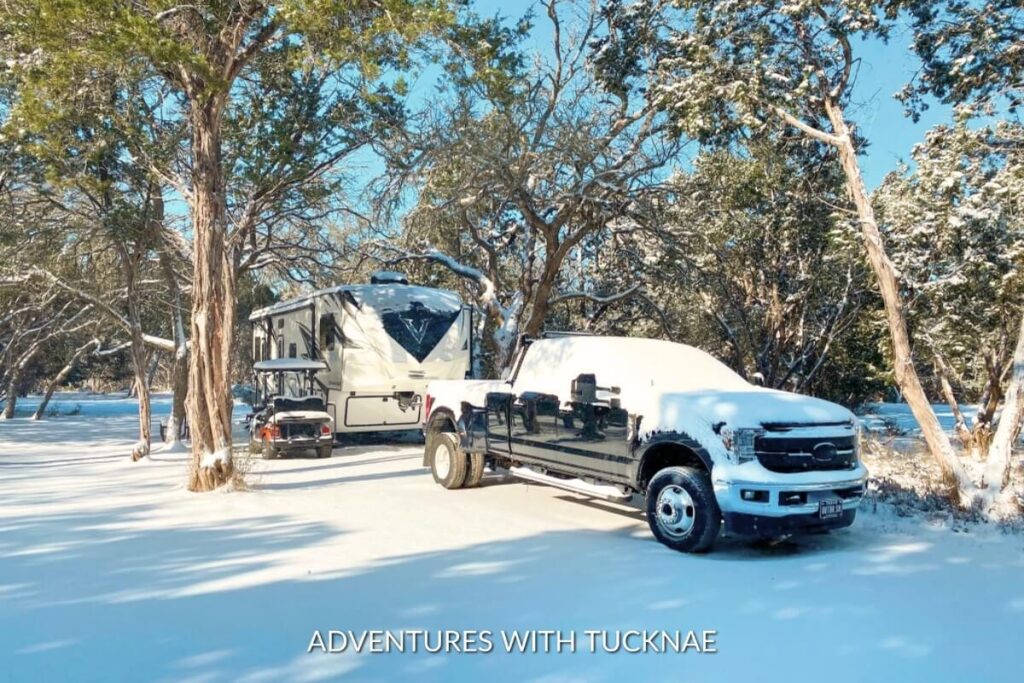
13. When & How to Winterize Your RV
Knowing when and how to winterize your RV is important for protecting it from the harsh effects of cold weather.
Here’s a guide on when to do it and the steps to follow:
When to Winterize:
- Temperature: You may want to consider winterizing your RV when temperatures consistently drop below freezing, which can vary by region. To be safe, consider doing it when the temperature hovers around 32°F (0°C).
- End of the Season: If you are not going to be camping in the winter, then typically, it’s best to winterize at the end of your camping season, just before the cold weather sets in. This ensures your RV is protected during the winter months.
- While Winter Camping: If you are camping in freezing temps and don’t have a way to protect your water lines from freezing and busting, you can winterize your RV while still using it. Obviously, you wouldn’t have clean, fresh water for drinking or showering, but you can still use and flush the toilet with antifreeze in your tanks.
How to Winterize:
- Drain All Water Systems: Start by draining all water tanks, pipes, and faucets. Open all the valves to ensure water is completely removed. You can also blow out all water lines.
- Bypass the Water Heater: Bypass the water heater to prevent antifreeze from entering it. You’ll use a separate winterizing kit to pump antifreeze.
- Add RV Antifreeze: Using an RV-specific antifreeze, pump it through your water lines until it comes out of all faucets, including showers and toilets. Flush the toilet and run water through the water lines for each faucet.
- Empty and Clean Tanks: Empty the black and gray water tanks. Clean and flush them thoroughly to prevent odors and buildup during the winter.
- Seal Windows and Vents: Seal any gaps around windows, doors, and vents with weatherstripping to prevent drafts.
- Remove Batteries: Store your RV’s batteries in a cool, dry place and keep them charged to maintain their health.
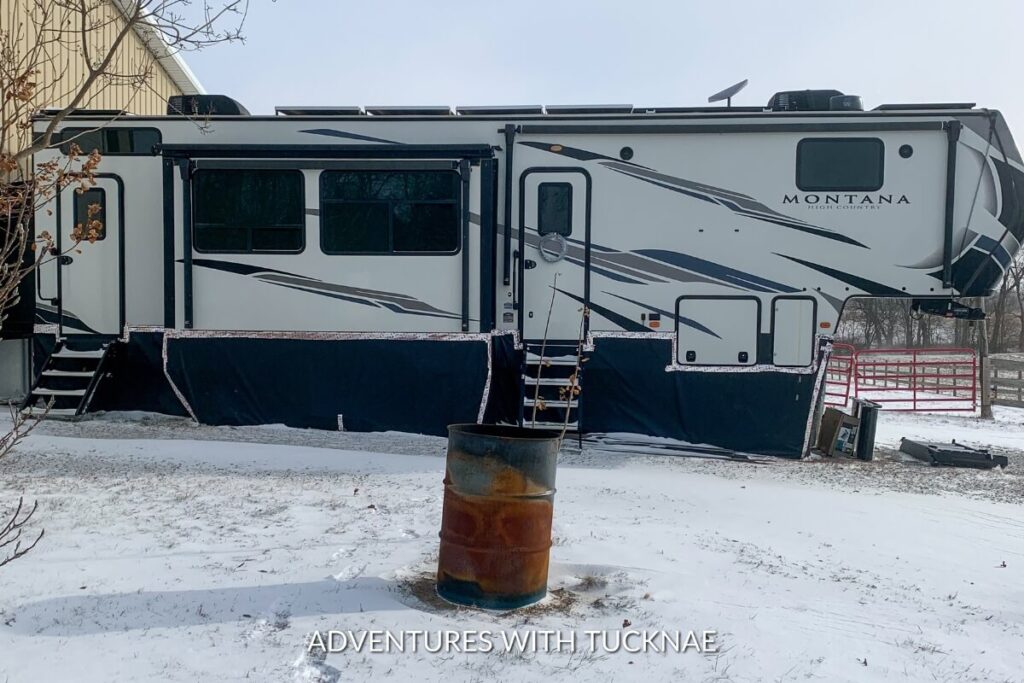
FAQ About RVing in Cold Weather
How cold is too cold for an RV?
Below-freezing temperatures are a concern; it’s important to be prepared or to winterize your RV to prevent damage in cold temperatures under 32ºF.
Can you drive an RV in cold weather?
Yes, you can drive an RV in cold weather, but be prepared for potential challenges like icy roads and cold interior temperatures.
Is it possible to live in an RV in the winter?
Yes, it’s possible to live in an RV in the winter, but you need extra insulation, heating, and possibly even winterization.
Is it hard to keep an RV warm in winter?
Keeping an RV warm in winter can be challenging, but it’s manageable with RV insulation, propane and electric heating, and sealing gaps.
How do I keep my RV from freezing in the winter?
Prevent freezing by winterizing your RV, using heated hoses, and keeping the interior warm with your propane heater.
How do you make an RV livable in the winter?
Make an RV livable in winter by insulating, adding DIY RV skirting, using quality heating sources, and managing condensation.
How do I protect my RV in freezing weather?
Protect your RV in freezing weather by winterizing, sealing gaps, and, if possible, covering it when not in use.
Will RV holding tanks freeze?
RV holding tanks can freeze in cold weather, but using tank heaters or insulating them can help prevent freezing.
In Closing: Winter RV Camping Guide: 13 Tips for RVing in Cold Weather
I hope you’ve found this list of tips for RVing in winter helpful!
Find More RV Tips & Advice
- Advice to Newbie RVers from 32 Full-Time RVers
- 8 Tips to Prepare for RV Travel Days
- 21 Unique Jobs for Full-Time RVers
- 7 Important RV Living Safety Tips
- RV Tip: How To Keep Glass Plates From Breaking in an RV
- Winter RV Camping Guide: 13 Tips for RVing in Cold Weather
- Easy RV Hot Water Heater Maintenance Guide + Cleaning Tips
- 101 Inspirational RV Quotes & the Best RV Camping Captions
- The 60+ Best RV Games For Indoor & Outdoor Camping Fun
- A Full-Time RVers Complete Guide to RV Laundry Solutions
- 10 of the Best RV Plants to Grow in an RV
Prefer watching instead of reading? Check out our detailed YouTube video below!
Is there anything you would add to this list? Be sure to let us know in the comments below what else you do to prepare for full-time RVing in cold weather!


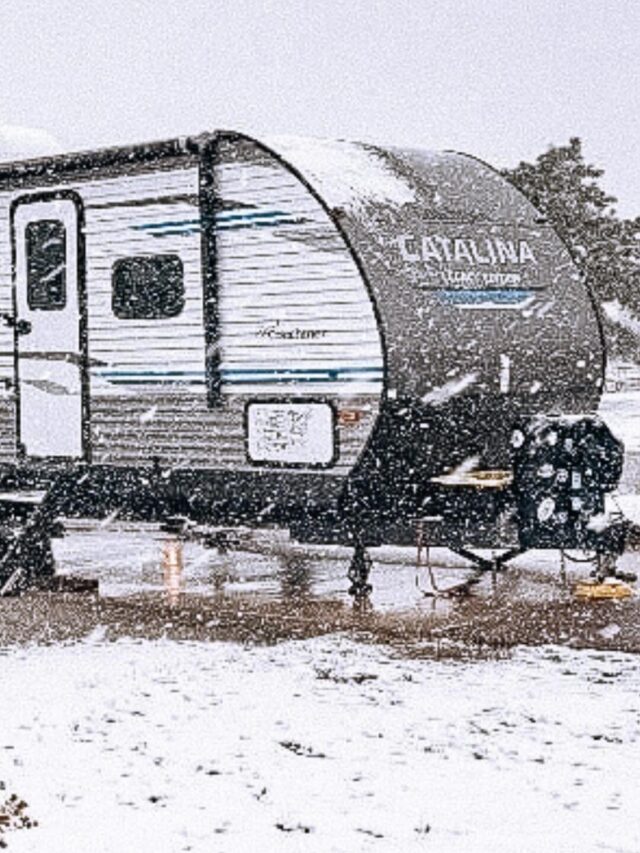

This wad JUST the blog post I needed yo read as winter is approaching!! I learned so many good tips I didn’t know before like running the furnace as well! Will be sharing with the hubs. Thanks Janae!!
Yay! So glad you found it helpful Laura! ♥️ Thanks for reading 😊
Great tips!! We usually chase the sunshine but definitely will be referencing if we ever find ourselves in some cold weather!
Enjoy the sunshine! ☺️
I was so curious about RVing in the cold weather since this is our first year. We’re home basing in FL but hope to venture out next year and this will be super helpful, thank you!
Florida sounds like the perfect place to winter! Enjoy your time there! ☺️